Louis Comfort Tiffany
Louis Comfort Tiffany | |
|---|---|
 Tiffany c. 1908
| |
| Born |
February 18, 1848
New York City, U.S.
|
| Died | January 17, 1933 (aged 84) New York City, U.S.
|
| Resting place | Green-Wood Cemetery (Brooklyn, New York City, U.S.) |
| Education |
Pennsylvania Military Academy Eagleswood Military Academy |
| Known for | Favrile glass, Tiffany lamps |
| Spouse(s) | Mary Woodbridge Goddard (1872–1884; her death) Louise Wakeman Knox (1886–1904; her death) |
| Children | 8, including Dorothy Burlingham |
| Parent(s) |
Charles Lewis Tiffany Harriet Olivia Avery Young |
| Signature | |
Louis Comfort Tiffany (February 18, 1848 – January 17, 1933) was an American artist and designer who worked in the decorative arts and is best known for his work in stained glass. He is associated with the art nouveau and aesthetic art movements.
He was affiliated with a prestigious collaborative of designers known as the Associated Artists, which included Lockwood de Forest, Candace Wheeler, and Samuel Colman. Tiffany designed stained glass windows and lamps, glass mosaics, blown glass, ceramics, jewellery, enamels, and metalwork. He was the first design director at his family company, Tiffany & Co., founded by his father Charles Lewis Tiffany.
Early life and education
Tiffany was born in New York City, the son of Charles Lewis Tiffany, founder of Tiffany and Company, and Harriet Olivia Avery Young. He attended school at Pennsylvania Military Academy in West Chester, Pennsylvania, and Eagleswood Military Academy in Perth Amboy, New Jersey.
Early Career
Tiffany's first artistic training was as a painter, studying under George Inness in Eagleswood, New Jersey, and Samuel Colman in Irvington, New York. He also studied at the National Academy of Design in New York City in 1866 and 1867 and with salon painter Leon-Adolphe-Auguste Belly in 1868 and 1869. Belly's landscape paintings had a great influence on Tiffany.
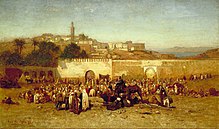


Tiffany started out as a painter, but became interested in glassmaking from about 1875 and worked at several glasshouses in Brooklyn between then and 1878. In 1879 he joined with Candace Wheeler, Samuel Colman, and Lockwood de Forest to form Louis Comfort Tiffany and Associated American Artists. The business lasted only four years. The group made designs for wallpaper, furniture, and textiles. In 1881, Tiffany did the interior design of the Mark Twain House in Hartford, Connecticut, which still remains.
History of Tiffany Studios
A desire to concentrate on art in glass led Tiffany to chose to establish his own glassmaking firm. The first Tiffany Glass Company was incorporated December 1, 1885, and in 1902 became known as the Tiffany Studios. In the beginning of his career, Tiffany used cheap jelly jars and bottles because they had the mineral impurities that finer glass lacked. When he was unable to convince fine glassmakers to leave the impurities in, he began making his own glass. Tiffany used opalescent glass in a variety of colors and textures to create a unique style of stained glass. Tiffany acquired Stanford Bray's patent for the "copper foil" technique, which, by edging each piece of cut glass in copper foil and soldering the whole together to create his windows and lamps, made possible a level of detail previously unknown. This can be contrasted with the method of painting in enamels or glass paint on colorless glass, and then setting the glass pieces in lead channels, that had been the dominant method of creating stained glass for hundreds of years in Europe.
Tiffany later opened his own glass factory in Corona, New York, determined to provide designs that improved the quality of contemporary glass. The factory was the old Tiffany Studios in Corona, Queens, at the southwest corner of 43rd Avenue and 97th place, where it was used to cast art sculptures of bronze designs for sculptors, and bronze architectural elements such as floor registers, door jambs, window casings, lamps, and sconces, most notably for Tiffany. The building had undergone a metamorphosis of name changes, beginning with the Tiffany Glass and Decorating Company, in 1892. In 1893, Tiffany built a new factory called the Stourbridge Glass Company, later called Tiffany Glass Furnaces, which was located in Corona, Queens, hiring the Englishman Arthur J. Nash to oversee it. In 1893, his company also introduced the term Favrile in conjunction with his first production of blown glass at his new glass factory. Some early examples of his lamps were exhibited in the 1893 World's Fair in Chicago. Arthur J. Nash apparently became Tiffany's partner, as Nash applied the favrile glass technique learned from his hometown of Stourbridge, England to the glassworks produced by Tiffany. Thereafter, its name evolved from being called the Stourbridge Glass Company in 1893 (in deference to the technique learned from Nash's hometown), to the Tiffany Glass Furnaces, and finally to the Tiffany Studios. Stourbridge Glass Company was absorbed by Tiffany into the Tiffany Furnaces in 1902.
Tiffany trademarked Favrile (from the old French word for handmade) on November 13, 1894. He later used this word to apply to all of his glass, enamel and pottery. Tiffany's first commercially produced lamps date from around 1895. Much of his company's production was in making stained glass windows and Tiffany lamps, but his company designed a complete range of interior decorations. At its peak, his factory employed more than 300 artisans. "Within this complex, Tiffany carried out experiments in glass colors and pottery glazing, perfected techniques of assembling stained glass windows." “By 1901, Tiffany was at the peak of his profession.
Tiffany’s glass fell out of favor in the 1910s, and by the 1920s a foundry had been installed for a separate bronze company. Tiffany's leadership and talent, as well as his father's money and old firm allowed Tiffany to relaunch Tiffany studios as a marketing strategy in order for his business to thrive. In 1932, Tiffany Studios filed for bankruptcy. Ownership of the complex passed back to the original owners of the factory — the Roman Bronze Works — which had served as a subcontractor to Tiffany for many years.” John Polachek, founder of the General Bronze Corporation —who had worked at the Tiffany Studios earlier— purchased the Roman Bronze Works (the old Tiffany Studios). General Bronze then became the largest bronze fabricator in New York City formed through the merger of his own companies and Tiffany's Corona factory.
White House
The new firm's most notable work came in 1882 when U.S. president Chester Alan Arthur refused to move into the White House until it had been redecorated. Arthur commissioned Tiffany, who began to make a name for himself in New York City society for the firm's interior design work, to redo the state rooms, which Arthur found charmless. Tiffany worked on the East Room, the Blue Room, the Red Room, the State Dining Room, and the Entrance Hall, refurnishing, repainting in decorative patterns, installing newly designed mantelpieces, changing to wallpaper with dense patterns, and adding Tiffany glass to gaslight fixtures and windows and adding an opalescent floor-to-ceiling glass screen in the Entrance Hall. The Tiffany screen and other Victorian additions were all removed in the Roosevelt renovations of 1902, which restored the White House interiors to Federal style in keeping with its architecture.
First Presbyterian Church in Pittsburgh
The First Presbyterian Church building of 1905 in Pittsburgh, uses Tiffany windows that partially make use of painted glass. Use of the colored glass itself to create stained glass pictures was motivated by the ideals of the Arts and Crafts movement and its leader William Morris in England. Fellow artists and glassmakers Oliver Kimberly and Frank Duffner, founders of the Duffner and Kimberly Company and John La Farge were Tiffany's chief competitors in this new American style of stained glass. Tiffany, Duffner and Kimberly, along with La Farge, had learned their craft at the same glasshouses in Brooklyn in the late 1870s. In 1889, at the Paris Exposition, Tiffany was said to have been "overwhelmed" by the glass work of Émile Gallé, French Art Nouveau artisan. He also met artist Alphonse Mucha. In 1900, at the Exposition Universelle in Paris, he won a gold medal with his stained glass windows The Four Seasons Recent research by Rutgers University professor Martin Eidelberg suggests that a team of talented single women designers, sometimes referred to as the "Tiffany Girls", led by Clara Driscoll played a big role in designing many of the floral patterns on the famous Tiffany lamp and other creations. Tiffany interiors also made considerable use of mosaics. The mosaics workshop, largely staffed by women, was overseen until 1898 by the Swiss-born sculptor and designer Jacob Adolphus Holzer.
Tiffany & Co.
In 1902, Tiffany became the first design director for Tiffany & Co., the jewelry company founded by his father. 1911 saw the installation of an enormous glass curtain fabricated for the Palacio de Bellas Artes in Mexico City. It is considered by some to be a masterpiece.


Tiffany used all his skills in the design of his own house, the 84-room Laurelton Hall, in the village of Laurel Hollow, on Long Island, New York, completed in 1905. Later this estate was donated to his foundation for art students along with 60 acres (243,000 m2) of land, sold in 1949, and destroyed by a fire in 1957. Aside from his fame for glass and jewelry design, Tiffany also designed what we know today as the New York Yankee's logo.
Personal life

Tiffany married Mary Woodbridge Goddard on May 15, 1872, in Norwich, Connecticut, and had four following children, including twin daughters:
- Mary Woodbridge Tiffany (1873–1963) who married Graham Lusk;
- Charles Louis Tiffany I (1874–1874);
- Charles Louis Tiffany II (1878–1947) who married Katrina Brandes Ely;
- Hilda Goddard Tiffany (1879–1908), the youngest.
After the death of his wife, he married Louise Wakeman Knox (1851–1904) on November 9, 1886. They had four children:
- Louise Comfort Tiffany (1887–1974), who married Rodman Drake DeKay Gilder;
- Julia DeForest Tiffany (1887–1973), who married Gurdon S. Parker then married Francis Minot Weld;
- Annie Olivia Tiffany (1888–1892); and
- Dorothy Trimble Tiffany (1891–1979), who, as Dorothy Burlingham, later became a noted psychoanalyst and lifelong friend and partner of Anna Freud.


Death
Tiffany died on January 17, 1933, and is interred in Green-Wood Cemetery in Brooklyn, New York City. Tiffany is the great-grandfather of investor George Gilder.
Societies
- American Watercolor Society
- Architectural League
- Chevalier of the Legion of Honour in 1900
- Imperial Society of Fine Arts (Tokyo)
- National Academy of Design in 1880
- New York Society of Fine Arts
- Société Nationale des Beaux-Arts (Paris)
- Society of American Artists in 1877
Source:
Awards and honors
- 1893: 44 medals, World Columbian Exposition (Chicago)
- 1900: gold medal, Chevalier of the Legion of Honour (France)
- 1900: grand prix, Paris Exposition
- 1901: grand prix, St. Petersburg Exposition
- 1901: gold medal, Buffalo Exposition
- 1901: gold medal, Dresden Exposition
- 1902: gold medal and special diploma, Turin Exposition
- 1904: gold medal, Louisiana Purchase Exposition in St. Louis
- 1907: gold medal, Jamestown Exposition
- 1909: grand prize, Seattle Exposition
- 1915: gold medal, Panama Exposition
- 1926: gold medal, Philadelphia Sesquicentennial Exposition
Source:
Collections
The Charles Hosmer Morse Museum of American Art in Winter Park, Florida, houses the world's most comprehensive collection of the works of Louis Comfort Tiffany, including Tiffany jewelry, pottery, paintings, art glass, leaded-glass windows, lamps, and the Tiffany Chapel he designed for the 1893 World's Columbian Exposition in Chicago. After the close of the exposition, a benefactor purchased the entire chapel for installation in the crypt of the Cathedral of Saint John the Divine, New York in New York City. As construction on the cathedral continued, the chapel fell into disuse, and in 1916, Tiffany removed the bulk of it to Laurelton Hall. After a 1957 fire, Hugh McKean, a former art student in 1930 at Laurelton Hall, and his wife Jeannette Genius McKean rescued the chapel, which now occupies an entire wing of the Morse Museum which they founded. Many glass panels from Laurelton Hall are also there; for many years some were on display in local restaurants and businesses in Central Florida. Some were replaced by full-scale color transparencies after the museum opened.
In November 2006, a major exhibit at Laurelton Hall at the Metropolitan Museum of Art in New York City opened. In 2007, an exhibit at the New-York Historical Society featured new information about the women who worked for Tiffany and their contribution to designs credited to Tiffany; the Society holds and exhibits a major collection of Tiffany's work. Since 1995, the Queens Museum of Art has featured a permanent collection of Tiffany objects, which continues Tiffany's presence in Corona, Queens where the company's studios were once located. Reid Memorial Presbyterian Church in Richmond, Indiana, has a collection of 62 Tiffany windows which are still their original placements, but the church is deteriorating and in jeopardy.
In 1906, Tiffany created stained glass windows for the Stanford White-designed Madison Square Presbyterian Church located on Madison Avenue in Manhattan, New York City. The church was Tiffany's place of worship, and was torn down in 1919 after the Metropolitan Life Insurance Company bought the land to build their new headquarters. Tiffany had inserted a clause in his contract stipulating that if the church were ever to be demolished, then ownership of the windows would revert to him.
Tiffany enjoyed staying at the Mission Inn in Riverside, California, and had become friends with the founder of the Mission Inn, Frank Augustus Miller, so, after meeting with Miller in New York, Tiffany shipped the windows to the Mission Inn; they arrived there in 1924, and were stored until the inn's St. Francis Chapel was completed in 1931. There are six rectangular windows and a 104” diameter window in the rear of the chapel, as well as another 104” diameter window is in the Galeria next to the chapel. A smaller window entitled “Monk At The Organ” featuring a Franciscan friar, is in St Cecelia's Chapel, a wedding chapel, and is engraved with Tiffany's signature. The St Francis Chapel was designed with the intent of prominently displaying Tiffany's windows. The Arlington Street Church in Boston has 16 Tiffany windows of a set of 20, designed by Frederick Wilson (1858–1932), Tiffany's chief designer for ecclesiastical windows. They were gradually installed between 1889 and 1929. The church archives include designs for 4 additional windows which were never commissioned due to financial constraints caused by the Great Depression. When funds again became available, Tiffany Studios had gone out of business and its stockpile of glass had been dispersed and lost, ending the prospect of completing the set. Also in the Back Bay district of Boston is Frederick Ayer Mansion, one of three surviving examples of Tiffany interiors, and the only surviving building also possessing exterior mosaics designed by Tiffany.
The Pine Street Baptist Church in Providence, Rhode Island, was opened in 1917 at Lloyd and Wayland Street as Central Baptist and in 2003, became known as Community Church of Providence. Between 1917 and 2018 the church featured a large Tiffany stained glass memorial to Frederick W. Hartwell that was created by Agnes F. Northrop and entitled "Light in Heaven and Earth". The complex work, considered "one of the largest and finest landscape windows ever produced by Tiffany Studios", largely was overlooked in the community.
In 2018, the church sold the window to the Art Institute of Chicago. After conservation and preparation, it will be displayed prominently as the Hartwell Memorial Window.
Significant collections of Tiffany windows outside the United States are the 17 windows in the former Erskine and American United Church, now part of the Montreal Museum of Fine Arts in Montreal, Canada, and the two windows in the American Church in Paris, on the Quai d'Orsay, which have been classified as National Monuments by the French government; these were commissioned by Rodman Wanamaker in 1901 for the original American Church building on the right bank of the Seine.
The Haworth Art Gallery in Accrington, England, contains a collection of more than 140 examples of the work of Louis Comfort Tiffany, including vases, tiles, lamps, and mosaics. The collection, which claims to be the largest collection of publicly owned Tiffany glass outside of the United States, contains a fine example of an Aquamarine vase and the noted Sulphur Crested Cockatoos mosaic.
Gallery
- Stained glass windows
-

-
Girl with Cherry Blossoms (c. 1890)
-
The Tree of Life stained glass
-
 Angel of the Resurrection (1904), in the Indianapolis Museum of Art
Angel of the Resurrection (1904), in the Indianapolis Museum of Art -
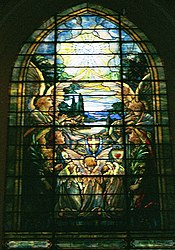 The New Creation, at Brown Memorial Presbyterian Church, Baltimore
The New Creation, at Brown Memorial Presbyterian Church, Baltimore -
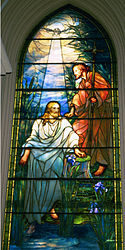 The Baptism of Christ, at Brown Memorial
The Baptism of Christ, at Brown Memorial -
 Nicodemus Came to Him by Night, First Presbyterian Church, Lockport, New York
Nicodemus Came to Him by Night, First Presbyterian Church, Lockport, New York -
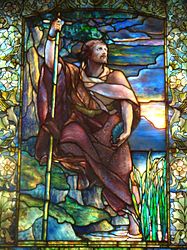
-
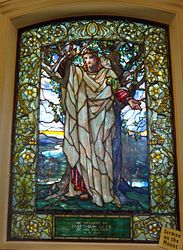 Sermon on the Mount at Arlington Street Church in Boston
Sermon on the Mount at Arlington Street Church in Boston -
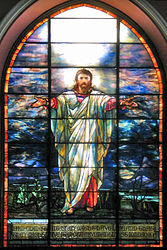 Christ the Consoler at Pullman Memorial Universalist Church, Albion, New York
Christ the Consoler at Pullman Memorial Universalist Church, Albion, New York -
 Corey Memorial Window (c. 1892-95), formerly at Christ Reformed Episcopal Church and now in the Art Institute of Chicago in Chicago
Corey Memorial Window (c. 1892-95), formerly at Christ Reformed Episcopal Church and now in the Art Institute of Chicago in Chicago
-
Education, the Chittenden Memorial Window at Yale University
- Tiffany Lamps
-
 Collection of Tiffany lamps from the Virginia Museum of Fine Arts
Collection of Tiffany lamps from the Virginia Museum of Fine Arts -
 Wisteria table lamp
Wisteria table lamp -
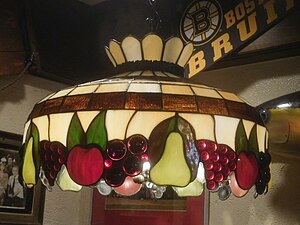 Tiffany ceiling light from the Cheers pub in Boston
Tiffany ceiling light from the Cheers pub in Boston














